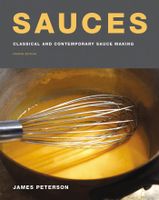Advertisement
Improving the Flavor of Tomato Sauces
Published 1991
- Use the best, ripest fresh tomatoes. When this is not possible, canned tomatoes can be used. There is much argument as to the best brands of canned tomato or tomato purée, but Redpack, Hunt’s, Pomi, and Delverde are well rated and seem like good ones to start using and comparing. Fresh tomato coulis or concassée can also be prepared in the summer and frozen for winter use if there is enough freezer space available for this to be practical.
- Avoid overcooking the tomatoes. Most recipes suggest preparing some kind of flavor base, adding the tomatoes, and cooking the mixture down until it thickens. It is best to precook and strain the liquid released by the tomatoes (as described for Cooked Tomato Concassée,) and cook the liquid down with the flavor base before adding the tomato pulp.
- The better the tomatoes, the less they benefit from additional flavoring and manipulation. But less-than-excellent tomatoes can still be used in an almost endless variety of ways. They can be cooked with meats and vegetables (either as a flavor base or in a stew); different herbs can enter into the bouquet garni (sage, oregano, marjoram, hyssop, basil) or be chopped and added to the sauce near the end (tarragon, chives, parsley, chervil); the sauce can be finished with cream, butter (plain or compound), hydrocolloids, or olive oil (flavored or not, or emulsified into a mayonnaise such as Aïoli, or Rouille). The sauce can be lent body and suavity by adding reduced stock or by combining it with stock and carefully reducing the two together (as in a classic espagnole). White or red wine can be added at the beginning and simmered with the flavor base.
Some tomato sauces, especially pasta sauces, are made by slowly roasting tomatoes in the oven, where they release a surprising amount of liquid. This liquid is ladled off, simmered down to a syrup on top of the stove, and combined with the chopped roasted tomatoes. This slow cooking lightly caramelizes the tomatoes and magnifies their flavor in a way that simple stove-top stewing will not.
Caramelization also enhances the flavor of sauces made with tomato paste (whole tomatoes contain so much water that they can be caramelized only by very long cooking). An excellent method for starting a traditional French or Italian tomato sauce is to sweat onions, carrots, celery, and garlic in olive oil until lightly caramelized, stir in tomato paste, and continue cooking until the tomato paste browns and smells toasty. A small amount of wine can be stirred in and quickly reduced to dryness before relatively neutral liquids such as stock or water are added and the sauce simmered just long enough to extract the flavor of the caramelized ingredients.
- The flavor of a tomato sauce can usually be improved by increasing both its sweetness and acidity and making sure the two are in balance. Chefs and home cooks have long added sugar to tomato sauces, especially when the tomatoes are underripe. What is less obvious is that even the flavor of acidic tomatoes is improved by adding a small amount of wine vinegar. Start by adding sugar, a small amount at a time, while tasting. As soon as you can taste the sugar, add vinegar a bit at a time, until you can taste it. Then balance the taste of the vinegar with an additional small amount of sugar. By increasing both the acidity and sweetness of the sauce, the flavor of the tomatoes will come into focus.

